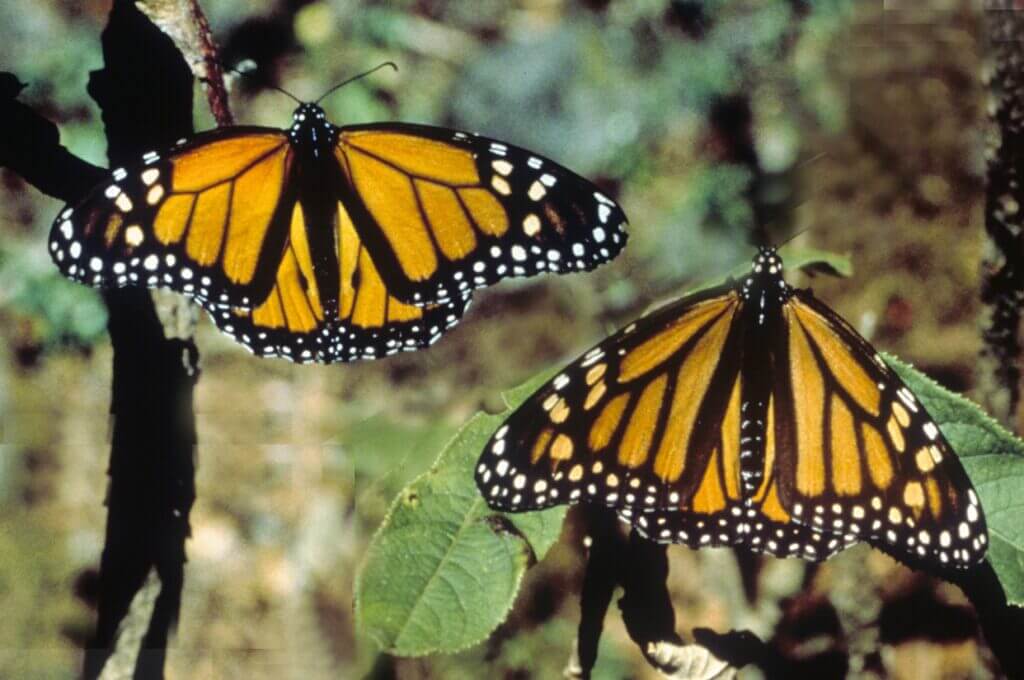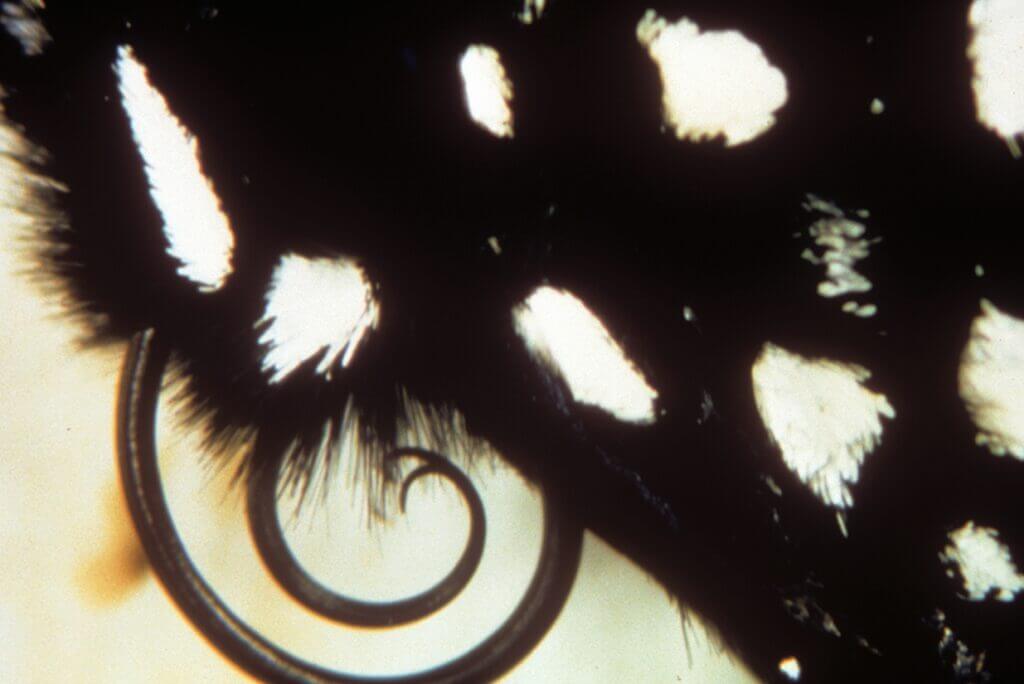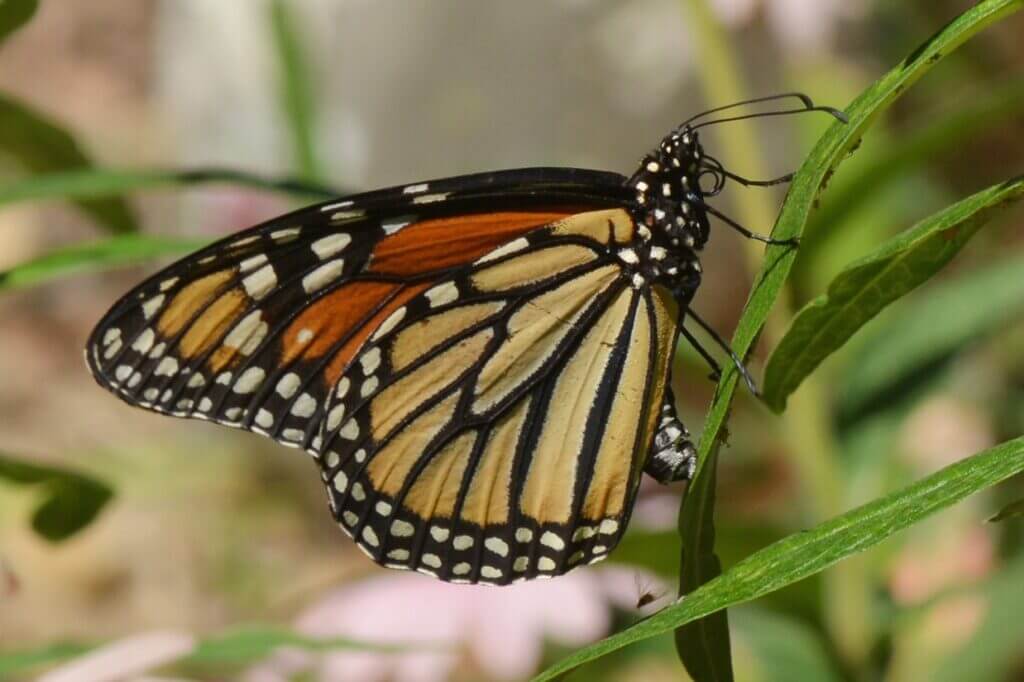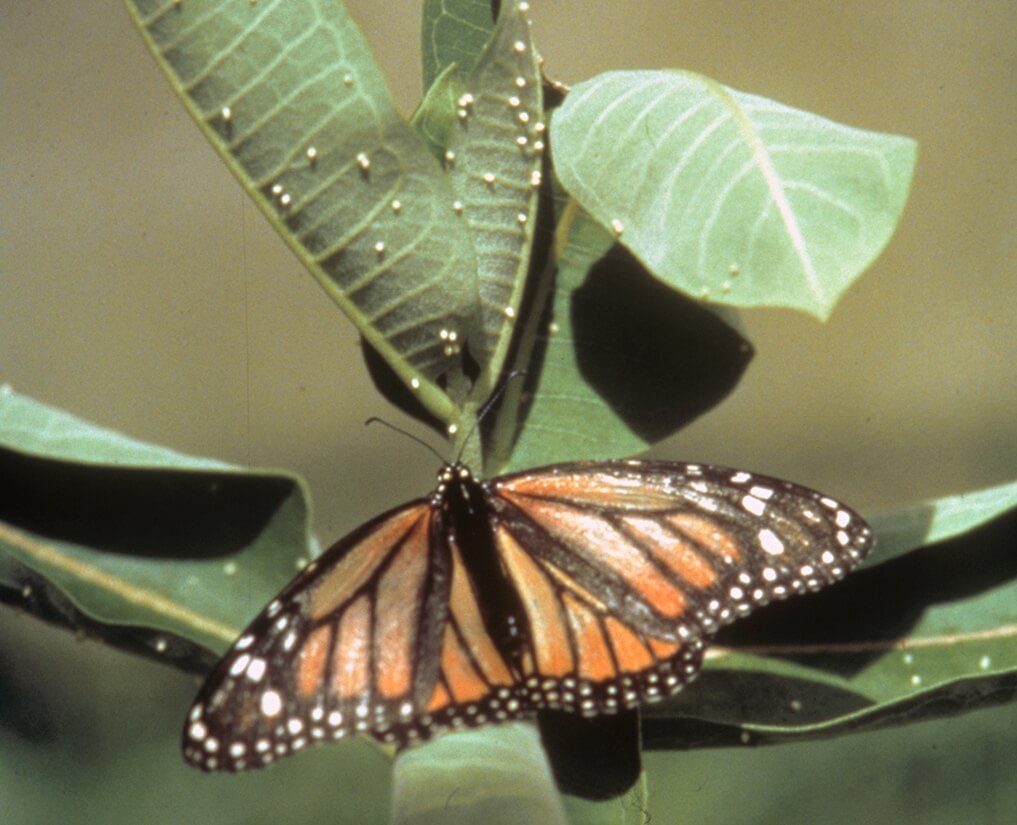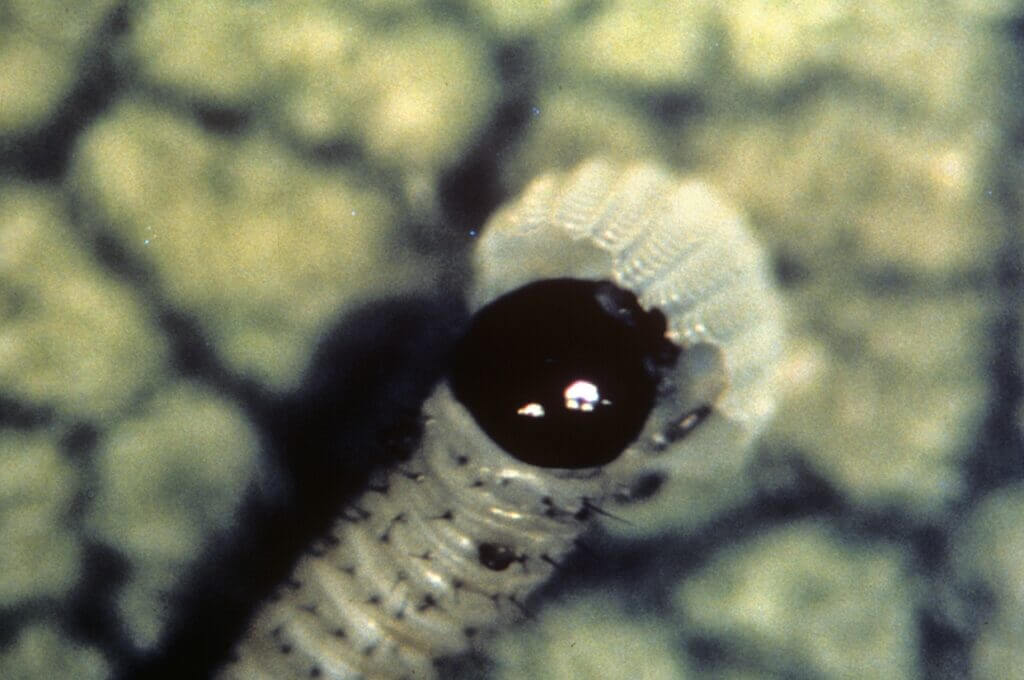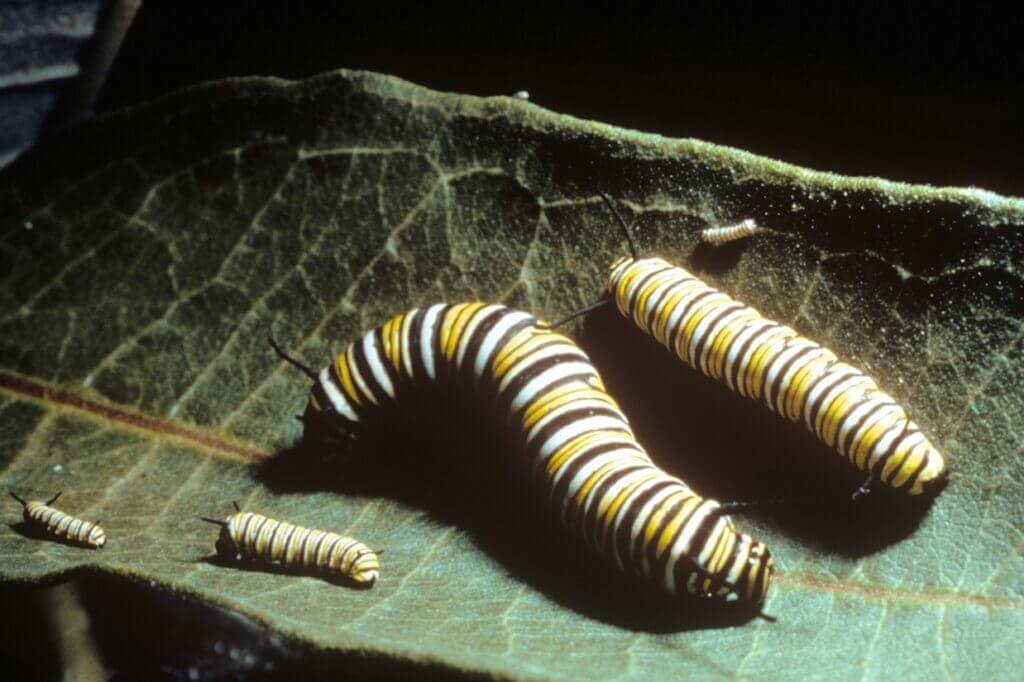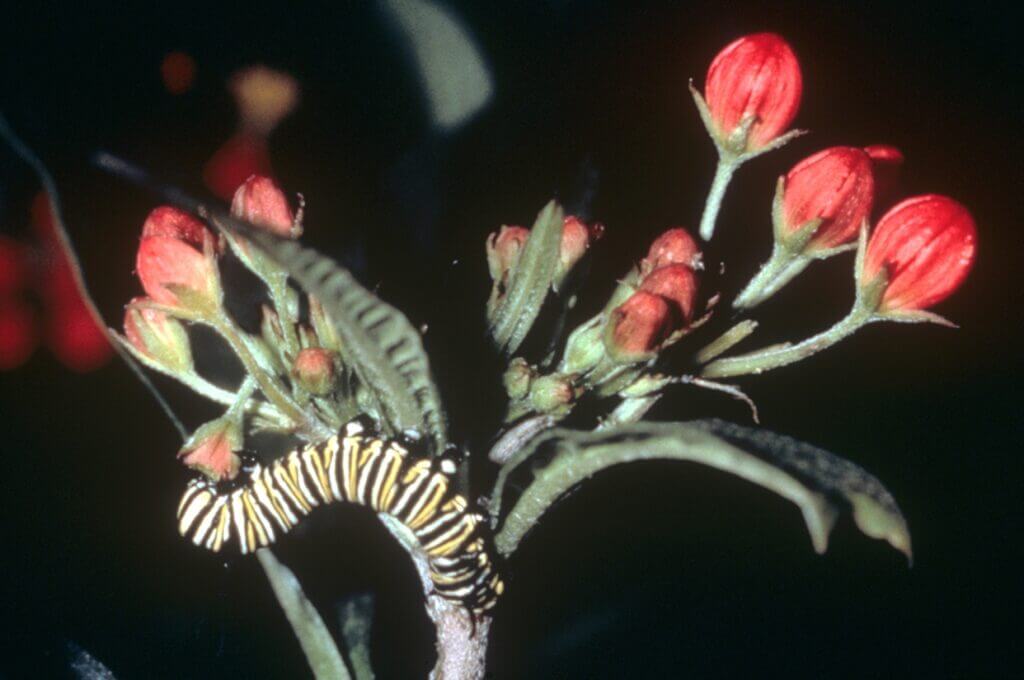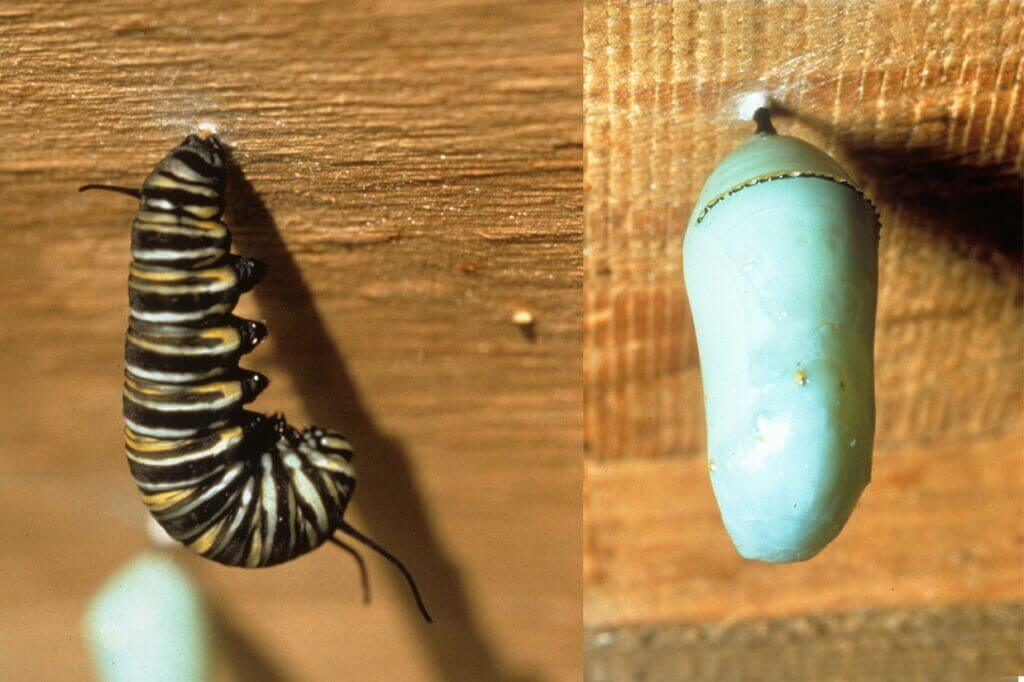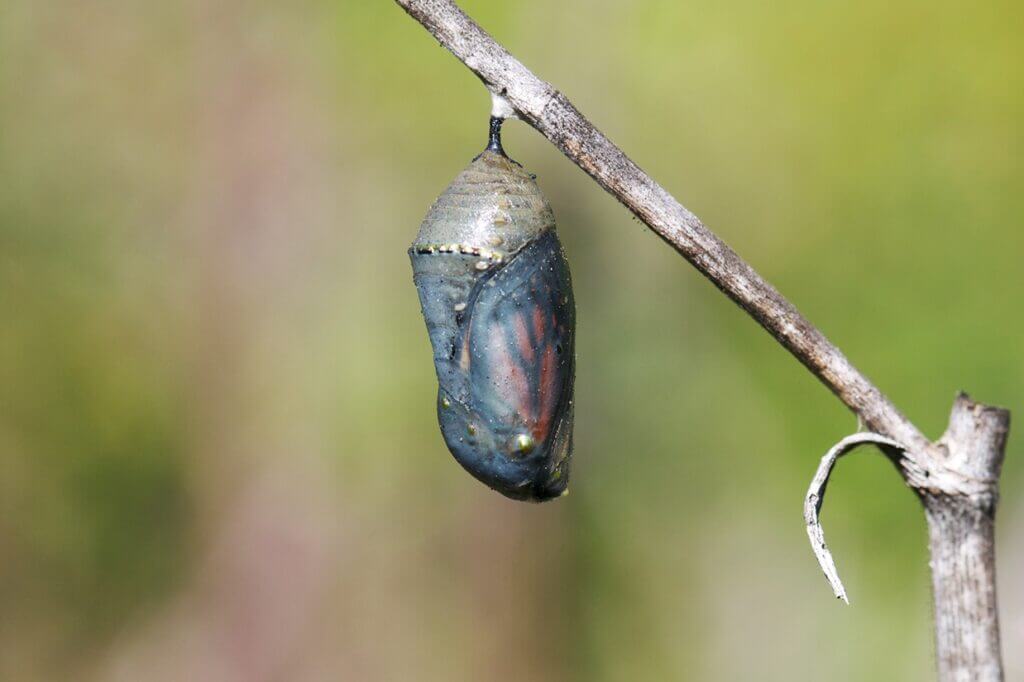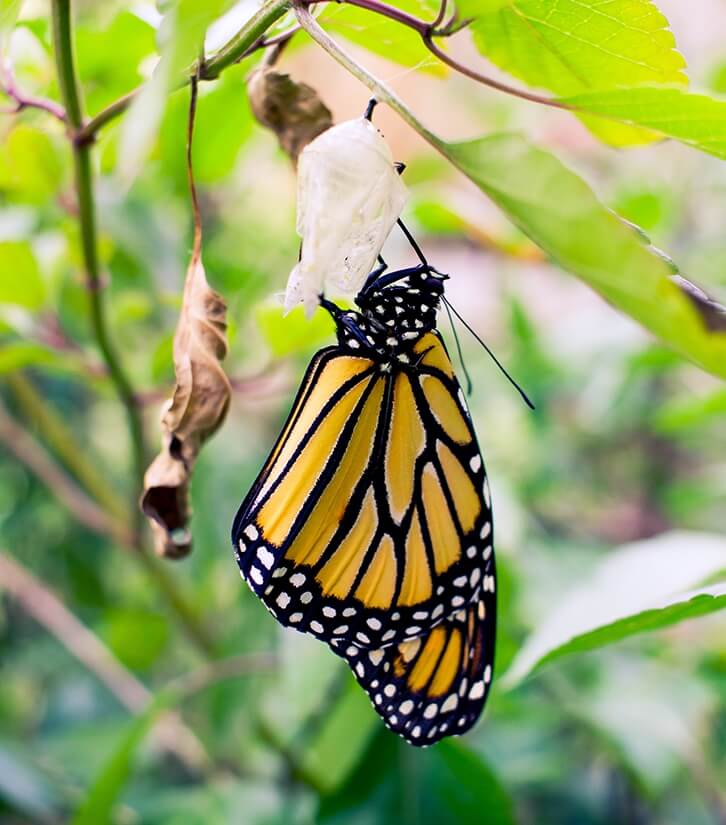All about Monarch Butterflies
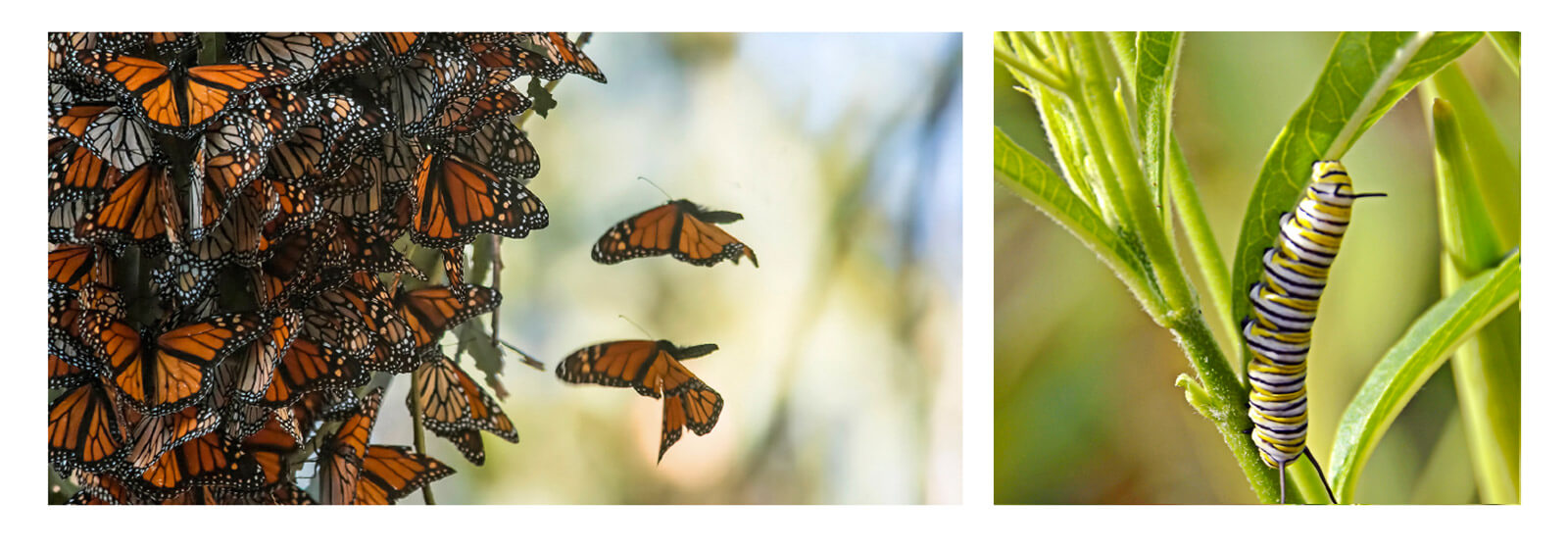
Many butterfly species have evolved in close association with certain plants and are often associated with distinct plant communities. Monarchs are dependent on plants in the milkweed family, which often grow in grasslands and meadows. They are also famous for the long distance migration of the species, a phenomenon that has only recently been studied in depth.
Here are a few basics about our beloved monarchs:
Butterflies are insects that go through a complete metamorphosis (holometabolous).
The four life stages are: egg, larva (caterpillar), pupa, and imago, or the adult stage (which we call a butterfly).
There are two populations of monarch butterflies in the United States: populations west of the Rocky Mountains over-winter on the California coast; populations east of the Rocky Mountains over-winter in Mexico.
There is no genetic difference between these two populations and probably some mingling at migrations, or occasional strays from one population to the other.
The migration is in two stages; first there is dispersal of the species from the over-wintering sites in early spring. These are adults that have already mated before they disperse. The descendants of these butterflies will migrate back to the over-wintering sites in late fall.Gravid females head inland searching for milkweeds on which to lay their eggs, and within a short time after that they die from old age.
The monarch has evolved in close association with milkweeds (Asclepidaceae); they are a monophagous species; their larvae do not feed on plants from any other genera.
The eggs hatch, larvae become adults, and this new generation of adults, both males and females, continue to move inland, mating and laying still more eggs on milkweeds.
There will be four or five generations of butterflies before the migration back to the over-wintering sites at the California coast.
It is a descendent of the individual butterfly that left the over-wintering site in spring that returns to the same over-wintering site the following fall. It is a migration of the species, not the individuals.
The monarch’s summer generations live only about 3 to 5 weeks in the adult stage, while the adults that over-winter live about 3 to 5 months.
Metamorphosis of the Monarch Butterfly
Monarch Migration
Monarchs in Marin County
Natural Enemies at All Stages
I’ll use the Monarch butterfly (Danaus Plexippus) for a quick tutorial on basic butterfly biology. I don’t have college degrees in entomology or botany, but I am autodidactic and through the combination of selected classes at the College of Marin, various independent workshops, lots of reading and research, and many, many hours spent observing caterpillars and butterflies, I can share what I’ve learned in layman’s terms. I have also raised many monarchs as well as other species of caterpillars over the last twenty years, but other butterfly species have not been so well studied. In some, the larvae are rarely seen; in some, the range of host plants has not been well documented. A really observant habitat gardener could actually add to our scientific knowledge of these creatures.
The following photos showing the life cycle of the Monarch are part of a Monarchs in the Classroom program developed at the University of Minnesota. Many thanks to Karen Oberhauser, from the Department of Ecology, for permission to use these photos for educational purposes.
Metamorphosis of the Monarch Butterfly
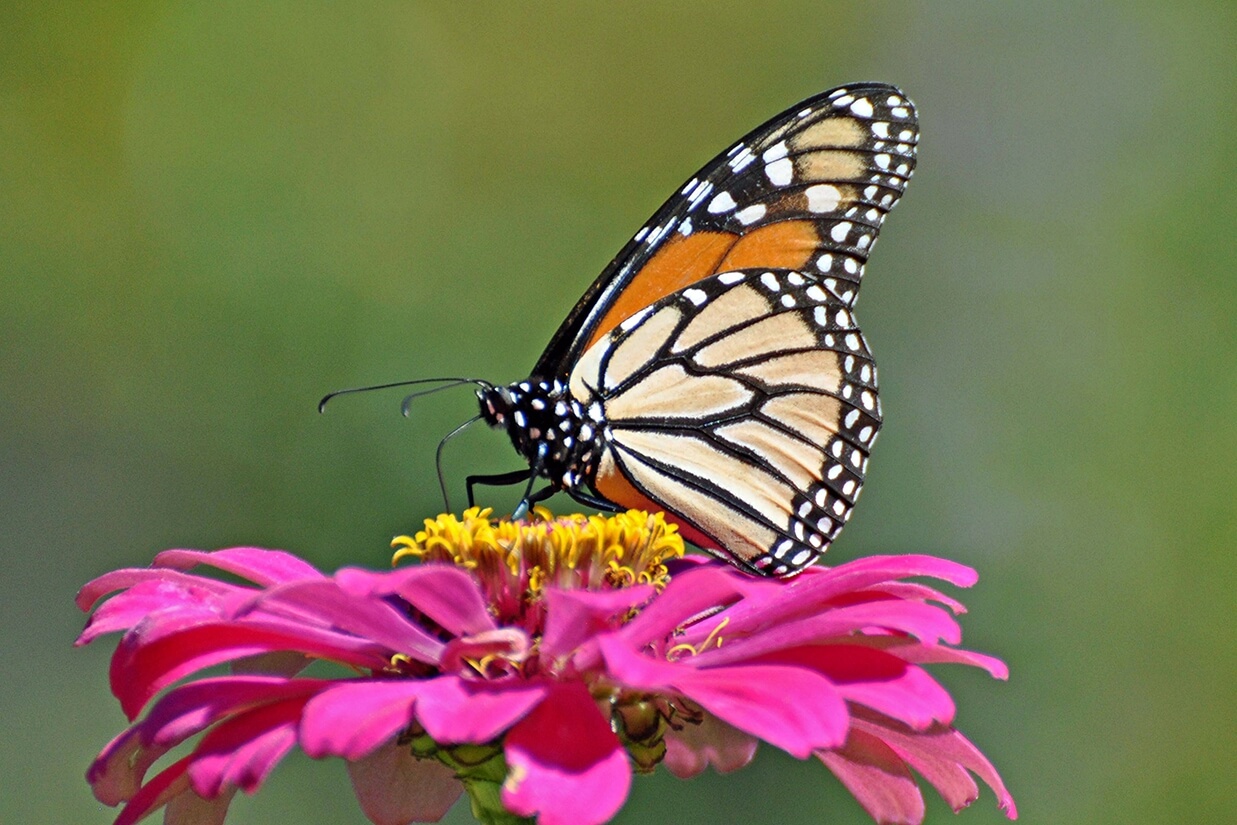
The monarch butterfly belongs to a very large family (Nymphalidae) that is commonly called the brushfoot family. All the varied butterflies in this family have one thing in common: the forelegs are greatly reduced and brush-like. Look closely at the adults and you can see that they walk on just four legs and everyone knows that insects have six legs! The tarsi (claws) on the brushfoot function as a sensory organ in the female, giving her a chemical reading of a plant; in males there is no known function.
In the adult (imago) stage of the Monarch butterfly, male and female can be distinguished. The male is usually larger and more brilliantly orange, with a swelling on one of the veins of the hind wings; this is a pheromone gland. (1) The female is browner and the black vein lines are broader.
The adults sip nectar from flowers through a feeding tube (2) (proboscis) that is curled up under the head when not in use. The adults do not grow—the nectar simply provides carbohydrates for the energy required for flight and reproduction. The main purpose of the adult life stage is to mate and lay eggs.
The female can lay as many as 500 eggs during her life span, but each life stage is vulnerable to all sorts of predation, so only about 2 to 10 percent of the eggs laid actually survive all the way to the adult stage! She chooses the host plant carefully, flitting about the plant, lightly touching down to take a chemical reading of the plant by drumming the tarsi on her brushfoots to determine that it is the best plant for her offspring. She then curls the tip of her abdomen to get close to the surface of the plant to lay her egg. (3) She rarely lays more than just a few eggs on any one plant. (4) This distinctive egg-laying behavior is easy to observe. She often lays her eggs on the underside of a leaf, or within a cluster of flower buds, where they are somewhat hidden.
Egg and Larvae
The egg is pearly white, and about the size of a pinhead; under a lens a beautiful ribbed pattern appears. The egg will hatch in about four to six days, turning dark just before the tiny larva emerges. (5)
Upon emergence from the egg, the larva is barely an eighth of an inch long with a white, translucent body and a dark head. The first thing they eat is their own eggshell, which is a source of protein, and then they start to feed on the leaf. They feed in between the veins of the leaf, and often just scrape at the surface of the leaf, in order to avoid the latex that runs through the veins, and could gum up their chewing mouthparts. Sometimes the tiny larva finds refuge amongst the flowers, feeding within a flower bud for the first few days; look for tiny holes in the flower buds. They are extremely vulnerable at this stage, since it takes a few days for the protective toxins to build up in their bodies.
Caterpillars are eating machines; this stage in the life cycle is all about eating, pooping, and growing! During the course of their development they go through five stages, known as instars. (6) In Monarchs, this takes about 10 to 14 days; during that time a larva has increased its body size by about 3,000 times! Larvae have six legs, just like all insects, but they are also equipped with “prolegs,” which are fleshy protuberances that end in “crochets” which can be hooked together like Velcro. These are used to keep a larva securely attached to the plant they are feeding on.
All lepidopteran larvae (caterpillars) produce a silken thread; it’s basically the same substance that humans have learned to harvest from silk moth cocoons to produce silk thread and fabric.
Caterpillars use this silk in a number of ways. Between each instar, the larva needs to shed its skin, called molting. To facilitate this process, the larva will create a silken pad which, when the crochets on the prolegs are secured to it, helps them literally walk out of the old skin! The old skin splits, revealing the new and larger skin beneath, which the larva quickly sets about filling out again. The larva usually eats the old skin and the silken pad, still another source of protein.
Caterpillars can also create a silken thread to quickly drop off a plant to a safer place.
On the ground they will be curled up and completely still until the danger has passed.
Then, when the perceived danger has passed, they can haul themselves back up on this string to resume eating.
The larva will feed on every part of the plant, including the flowers (7) and the seedpods. Milkweed plants that have supported larvae, which may have eaten every leaf and flower on the plant, will grow new leaves within a few weeks if the season is right.
Later instar larvae often notch the midvein of a leaf before eating it. This may be to create a safe, hidden place to feed, but it also stops the flow of the milkweed latex, which can gum up the larvae’s chewing mouthparts.
Pupa
When the larva is ready to pupate, it seeks out a protected location, often wandering far away from the host plants. I’ve noticed that the consistency of the poop (insect droppings are technically called frass) changes from a more solid form with a brownish color to a softer form with a green color, a day or so before the larva prepares to pupate. It spins a silken pad, and then attaches itself to this pad with its anal prolegs. (8) It will hang, upside down for about a day, in this J shape. The J relaxes, and the body of the caterpillar becomes straight, just before the old skin splits. The pupa is revealed beneath, somewhat misshapen, and the body of the larva is now somewhat of a “cellular soup.” Even so, (and this is really remarkable to watch!) there will be a lot of wriggly movements, and within about twenty minutes, the perfectly shaped pupa is formed.
The monarch pupa, or chrysalis, is adorned with tiny golden flecks; these glitter with light and movement, and may help to camouflage the pupa by obscuring its form. (8) There are many creatures that prey on the pupal stage, including large wasps that cut a hole right through it and eat the contents. The pupal stage usually lasts 10 to 14 days.
One of the final changes that takes place within the pupa is the development of pigmentation of the scales on the wings. The day before the butterfly is ready to emerge (eclose) from the pupa, its folded wings are visible through the pupa. (9) When it first emerges from the pupa, usually in the morning, its abdomen is very large, and the wings are quite small. The wings gradually unfold as the fluids in the abdomen are pumped into the veins of the wings. The butterfly needs a good perch to hang onto and plenty of room for the wings to attain their full size and shape. It takes several hours for the wings to become hard enough for the butterfly to fly. (10) The butterfly also needs to join the two parts of its proboscis together to create a tube through which it can feed.
Metamorphosis is an amazing, but also delicate process, fraught with problems late in the season. I found a pupa attached to one of my nursery pots in November. This monarch emerged from the pupa late in the month, and the wings hardened properly. It was very lethargic, so I brought it flowers to feed from, but still it did not fly off. Within a few days the butterfly expired, and on close examination I could see that it was not able to join the two parts of its proboscis together, and so could not feed.
A monarch butterfly in the garden, flitting from one flower to another seeking nectar, is a wonderful sight (11). Once milkweeds are established and you also see their larva in your garden, there is great satisfaction in knowing that you have provided for the complete life cycle of an amazing insect!
Monarch Migration
Monarch butterflies are famous for their seasonal migrations; these movements were noticed and congregations were suspected. During the 1960’s, at about the same time as the Browers were studying the toxicity of both the monarchs and the milkweed plants, Canadian biologist Fred Urquhart and his wife began to tag adult butterflies in the eastern U.S. population, hoping to recover them in order to discover where they went.
The Urquharts also enlisted lots of citizen scientists to assist with tagging monarch butterflies. It wasn’t until 1976 that a monarch tagged in Minnesota was discovered 1,750 miles away in Mexico! The specific over-wintering sites in the Sierra Madre Mountains, along the spine of central Mexico, were kept secret for several more years. By 1986, at least one of the five over-wintering sites in the Oyamel forests, Cerro Altamirano, was officially protected.
Monarch butterflies are able to fly at temperatures above 55 degrees and they make use of thermals to cover long distances. Much like many hawks and turkey vultures, these butterflies will spiral up on a thermal, and then glide effortlessly to the next thermal, covering long distances without expending much energy. During the northward dispersal in spring these small creatures (each butterfly weighs less than one gram) can fly for ten hours a day and cover about 45 miles. To get through the 135 days of entropy at the over-wintering sites, they build up a store of lipids, and after that energy is all used up the butterflies will pause to refuel, mate, and search for their larval host plants.
With still dismally low numbers of monarch butterflies at the California coastal over-wintering sites in the December 2018 and 2019 counts, it’s possible that it is the migration patterns that are endangered and may change dramatically. It’s interesting to note that there are no records of western monarch migrations or over-wintering sites on the California coast before the 20th century. Since there is no genetic difference between the east and west coast monarch populations in the U.S., it’s possible that California will eventually be repopulated with individuals from colonies in Mexico.
Monarchs also have colonized Australia, and there they simply live out their life cycle in areas close to the coast where the milkweeds grow. In Florida, Cuba, and in parts of Mexico there are also non-migratory populations. Monarchs have also colonized Hawaii, where there is an occasional pure white variant form.
Monarchs in Marin County
About twenty years ago I used to see monarchs coming through Marin in the spring, usually March to April, heading to inland meadows where the milkweeds were plentiful, and then again in the late summer on their way back to the over-wintering sites. For the last ten or twelve years I only see them in Marin in the late summer and fall, usually late August through October. The females often still have eggs to lay and, if the warm weather holds, caterpillars can make it all the way through the metamorphosis and join their brethren at the over-wintering sites along the coast.
Boom and bust cycles are often the norm in insect populations, sometimes with fluctuations as drastic as ten to one. I personally think that the fires that raged in northern central California for months in the summer of 2018 may have had a dramatic effect on the monarch populations. Monarch larvae could well have been in that area when the fires started in June, and died as the fires burnt the grasslands and milkweeds, as well as scrublands and forests. Smoke in the air could have also had a deleterious effect on the adults, killing them by clogging their spiracles, or confusing their sense of direction, rendering them unable to make the return to the coast.
Natural Enemies at All Stages
As if it isn’t hard enough to survive as a butterfly!
An adult female in the wild will mate on average 3 to 6 times, and can lay about 300–500 eggs. During this stage and the very first larval instars stage, there is about a 90% loss, mostly to invertebrate predators: ants, all sorts of true bugs, ladybird beetles and their larvae, lacewing larvae, syrphid fly larvae, wasps, red velvet mites, spiders and cockroaches will all eat butterfly eggs and the tiny caterpillars.
In addition, butterfly larvae are also vulnerable to parasitoids, especially the smooth-skinned species like the monarch. One species of braconid wasp will lay their eggs in the body of the larvae, and twelve different species of tachinid flies also use the larvae as a living host for their own larvae. The tachinid fly is known as the bane of the Monarchs. Even in the pupal stage there is predation; I’ve seen the pupa disintegrate after a large wasp has drilled a hole and sucked out the contents as a meal.
Monarch caterpillars in later stages are somewhat less vulnerable to predation, having gained some protection from the organic chemical compounds contained in the milkweed plants. They sport the warning coloration but that is only something that visual predators like birds pay attention to, and juvenile birds have to learn that the colors mean this creature tastes bad and will make them feel sick.
Even at the over-wintering sites the adults are at risk of predation: spiders, wasps, mantids, and dragonflies will pick off the resting butterflies. Mice and birds (like the grosbeaks, who know to avoid parts where the toxins are sequestered) pick off about 15% of an over-wintering colony.


